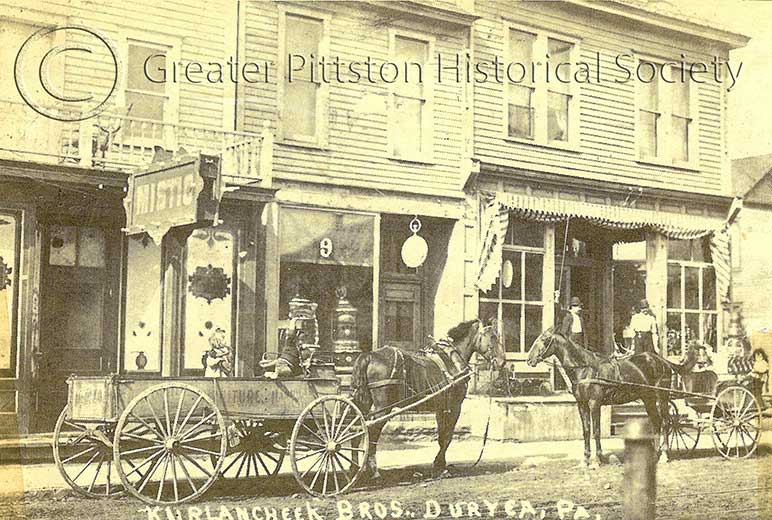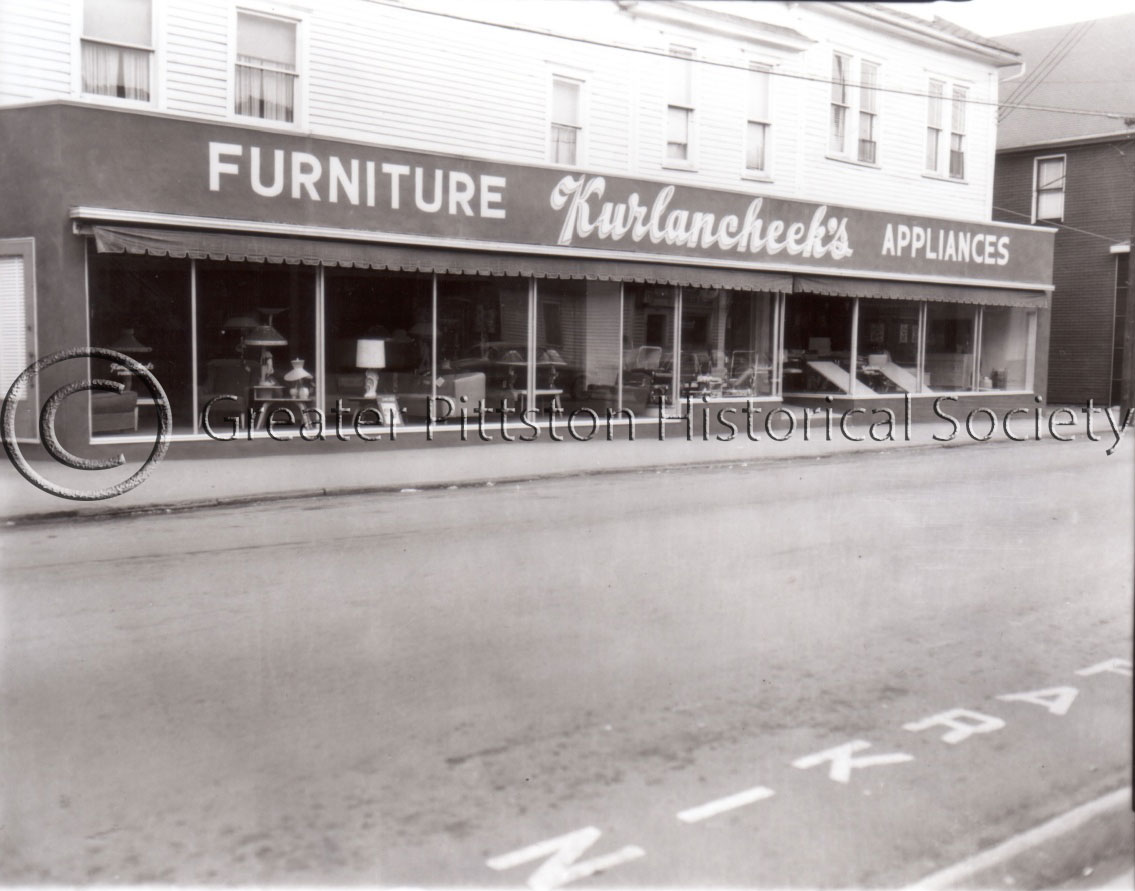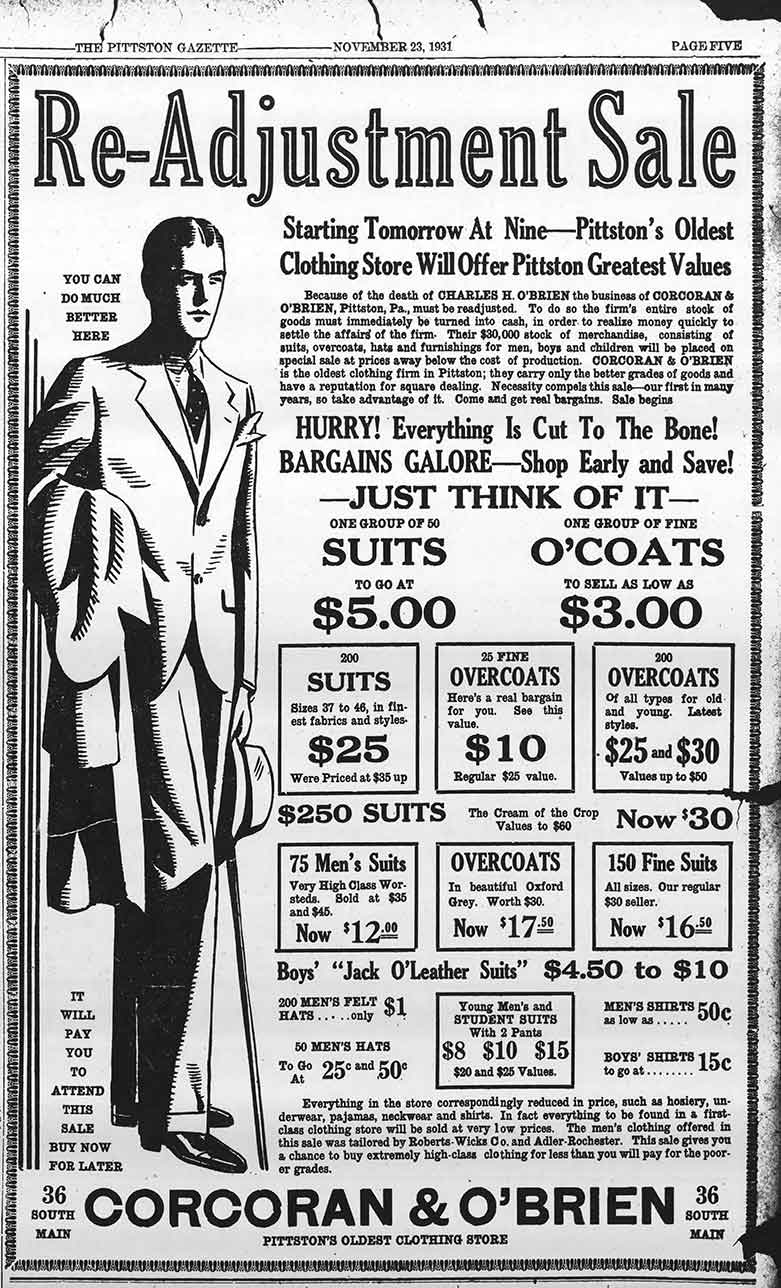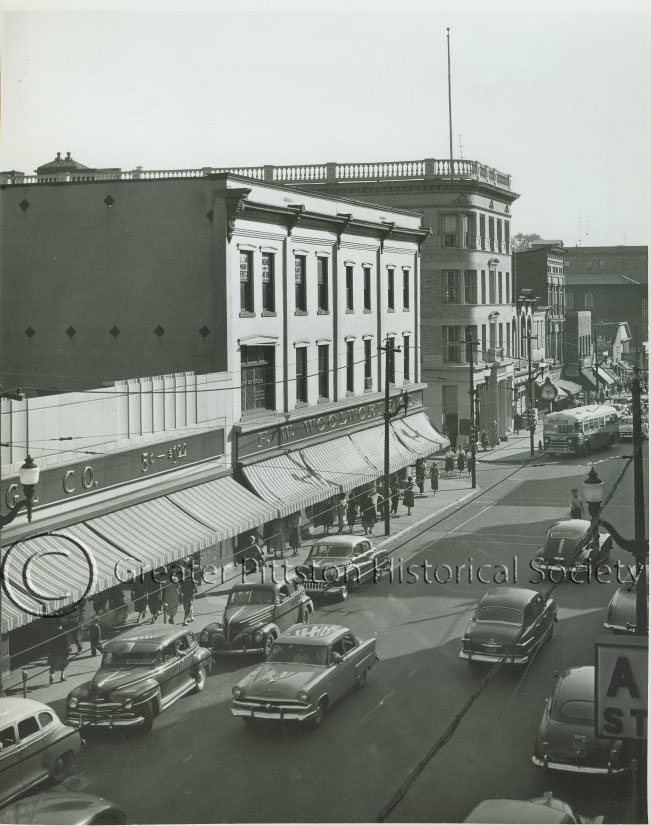
Main Street Pittston, September 1953. Mike Savokinas Collection (MS0000.1.247), Greater Pittston Historical Society, Pittston, PA.
“It was a booming town” –Blair Corcoran
The Greater Pittston area is made of various small townships that are located in-between the cities of Wilkes-Barre and Scranton. This community of towns makes up one of the larger areas of Italian, Irish, Polish, and German immigrants in Luzerne County. Because of this influx of European immigrants to this area in the early 1800s, the area’s business and industry gained a great deal of new skills. The Greater Pittston area’s business and industry came mostly from coal mining, railroads, and local independent businesses. The Irish, Polish, and German immigrants are remembered by locals as being a driving force for the growth of mining and the railroads. They and others also established local businesses that provided essential goods and services to the thriving industrial community.
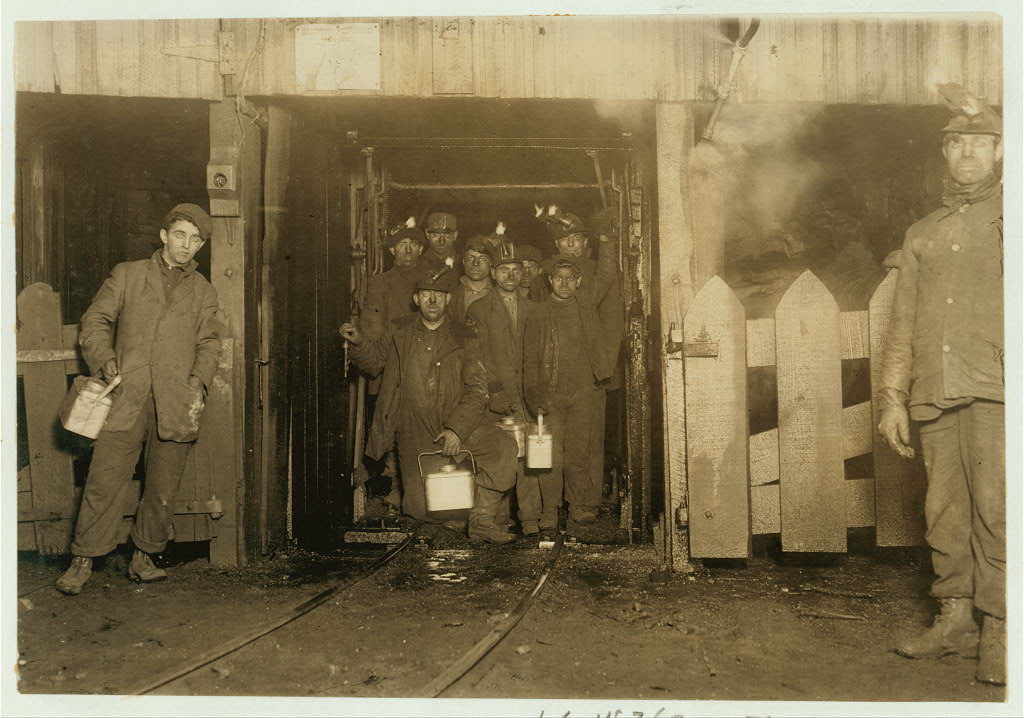
Lewis Hine, Close of the Day in South Pittston (1911), Library of Congress, Prints & Photographs Division, National Child Labor Committee Collection, (LC-DIG-nclc-01114).
The first, and most lucrative industry that was set up in the Greater Pittston area was the coal industry. The industry in this coal rich valley stretches as far back as the early 1770s. While the early miners only used surface mining techniques, they were actually the first miners of the Wyoming Valley. The largest anthracite coal basin in Pennsylvania, the Northern Basin, is located in this valley. When miners in the valley found how much coal was waiting down below, they turned away from surface mining and went towards deep earth mining. By the early nineteenth century, the mining industry in Northeastern Pennsylvania had emerged. Some of the most prominent companies in the region include: The Lehigh Valley Coal Company (1820), The Pennsylvania Coal Company (1838), The West Pittston Coal Company (1856), and Pittston Coal Company (1875). Around the turn of the century, coal was at its peak, and it was the highest paying profession around Pittston.
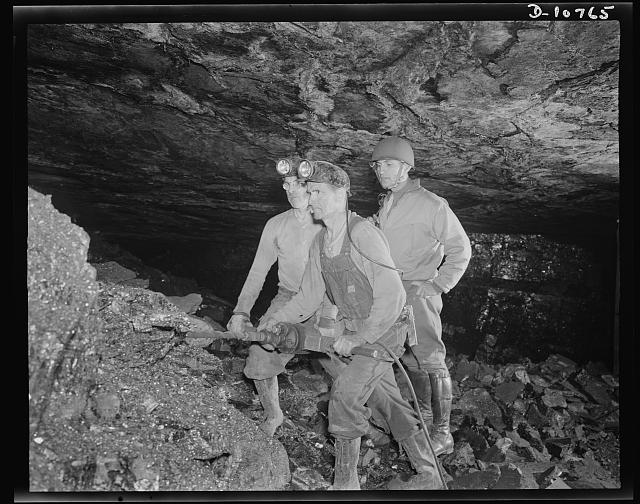
William Perlitch, War Production Drive- Anthracite Rally in Luzerne County, PA; Miners demonstrating pneumatic drill for servicemen. Library of Congress, Prints & Photographs Division, FSA/OWI Collection (LC-USE6-D-010765).
Over the next fifty years the coal industry would began to decline, and in 1959 the coal industry in Pittston would come to a sudden halt. On January 22, 1959, one of the River Slope Mine’s (owned by Knox Mining Company) tunnels collapsed underneath the Susquehanna River, resulting in the deaths of twelve miners. This disaster came to be known as the Knox Mine Disaster; it also resulted in the end of deep mining in the Wyoming Valley due to the fact that most companies had their mines interconnected.
With the big boom of the coal industry in the Greater Pittston area, came the need for an adequate transportation infrastructure. The river was a viable source of transportation but it was not the fastest, nor the most direct route. When the mining industry began to grow in the late 1840s, so did the railroad industry. These two industries would not only develop side by side, but they would become mutually dependent as the decades progressed. Just as coal companies depended upon the railroads to transport large loads of coal for a low price, the railroads increasingly depended upon coal as a primary fuel for steam engines, and needed the freight revenues to continue to grow. The two industries thus formed a symbiotic relationship. Some of the railroad companies that transported coal in and out of the Wyoming Valley and the Greater Pittston area included The Reading Blue Mountain & Northern Railroad and the Luzerne & Susquehanna Railroad. While these two companies provided transportation services only, other companies sought vertical integration to control both the mining and transportation processes involved in getting coal to market. They were the Pennsylvania Coal Company (which created a forty six mile railroad from Port Griffith [Pittston] to Paupack Eddy [Hawley], this allowed them to directly ship anthracite from the mines to the Hudson Canal and Delaware), and the Lehigh Coal and Navigation Company (which had merged its two industries to monopolize markets). The railroad companies used a staging area that was located in Duryea–called the Duryea Yard— to organize most of the outgoing coal cars. This meant that any railroad cars hauling coal would have to come through the Pittston area, giving it more and more ancillary business in the retail and service trades.
Another prominent industry in the Greater Pittston area was the local businesses. When the coal and rail companies had a great presence in the area, the local shop owners had an influx of customers (including miners, railroad workers, and their families). Because of these two industries, the food shops, clothing shops, furniture shops, and other local businesses thrived, catering to the vast amount of people and developers moving to the area. Of the stores established around the turn of the century (the peak of the mining industry in the region), there are but a few shops that made it through into the twentieth century. The only two remaining stores that still exist today are Kurlancheek Home Furnishings and Helen Brigido’s hardware store, Quality Roofers, Builders, and Hardware. A big part of the local business scene was the women that ran many of the stores. Two prominent women were Helen Brigido and Ronne Kurlancheek. They joined business enterprises out of necessity as young women—they either had to contribute to the family income (Helen’s case) or assist in running the family store (Ronne’s case). Regardless, these women gained valuable experience working in business during the mid-twentieth century, at a time when most women were expected to stay home and be housewives. The skills they developed as pioneering young women in a field typically dominated by men has served them well—both women still operate successful stores in the area. Brigido was even chosen for an award from the Greater Pittston Chamber of Commerce.
—Cody Spriggs
The Hughestown Coal Breaker
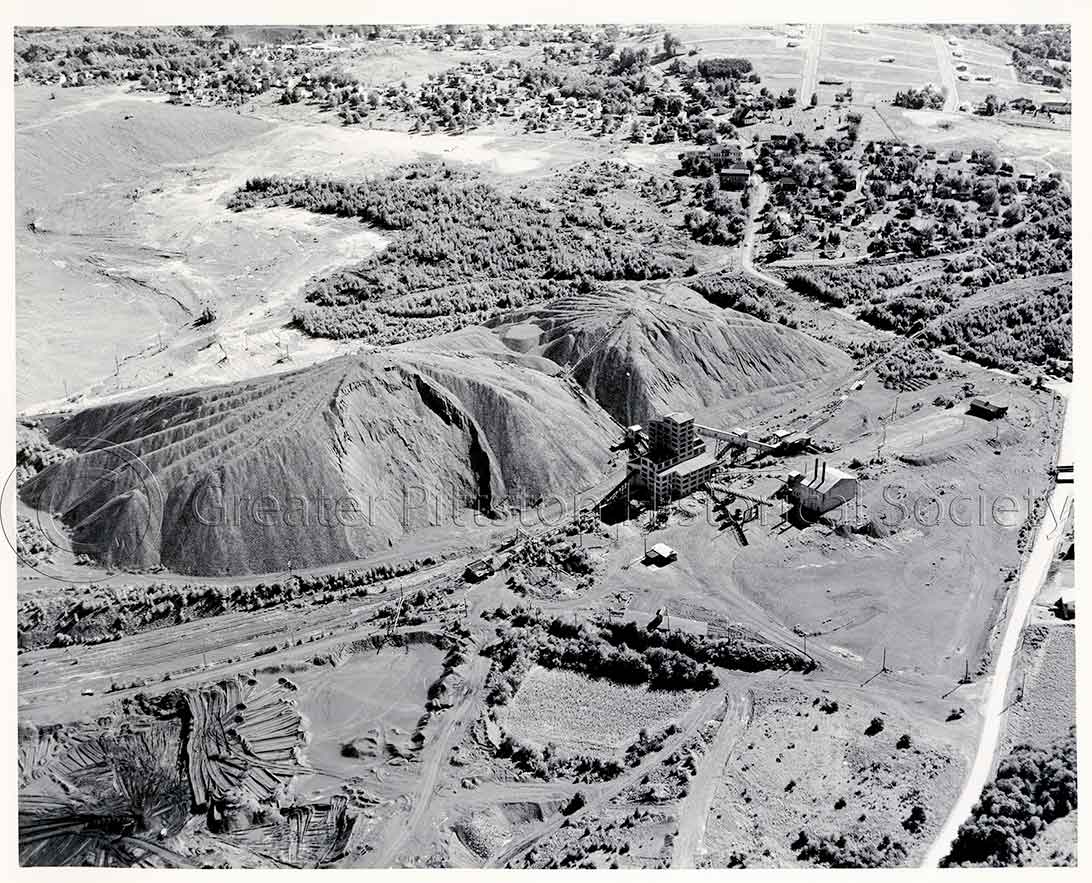
Hughestown Coal Breaker near Pittston, PA, Lukasik Studio Negatives Collection (5000.1.1753), Greater Pittston Historical Society, Pittston, PA.
This picture shows a coal breaker in the northeast anthracite coal fields of Pennsylvania. A coal breaker’s job was to handle all of the raw coal from the mines. Once the coal arrived at the processing plant, young boys would sit on boards across the conveyor belts and crack the coal with their feet, as shown in this notable photograph (below) from 1911 taken by social reformer Lewis Hine.
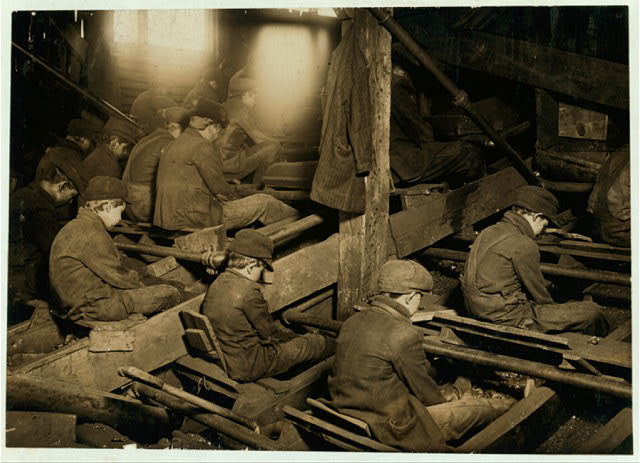
Lewis Hine, “A view of the Pennsylvania Breaker. The dust was so dense at times as to obscure the view. This dust penetrates the utmost recess of the boy’s lungs. Location: South Pittston, Pennsylvania,” (1911). Library of Congress, Prints & Photographs Division, National Child Labor Committee Collection, (LC-DIG-nclc-01133).
This process was important to coal production overall because it not only sorted the coal, but it removed impurities from the coal loads (shale, and slate). Once the impurities and undesired coal were sorted out, they were dumped into the culm pile (a pile of unusable products) that was usually near the breaker. The clean load was then loaded on to train cars and shipped to distributing plants.
This breaker featured here is the number 9 Hughestown coal breaker, located in Hughestown Pennsylvania. Hughestown is about 1/4 -mile away from Pittston’s city center, to the northeast of the Hughestown Hose Company. When this coal breaker was operational, it handled many tons of the anthracite coal that came through the Wyoming Valley. This is an aerial view of the breaker and the surrounding area. The breaker is in the center of the picture, the culm pile is to the direct left of the breaker. There is a town to the north (likely a town that provided miners for the mine), along with various little buildings scattered around the country side. Right in front of and directly behind the breaker are train tracks, where railroad cars could get close to the breaker to unload the dirty coal, and to pick up the clean filtered coal. When the mining industry declined in the region after 1959, the breaker was dismantled. The land where it stood has since been made into a housing development.
—Cody Spriggs
Investing in Coal
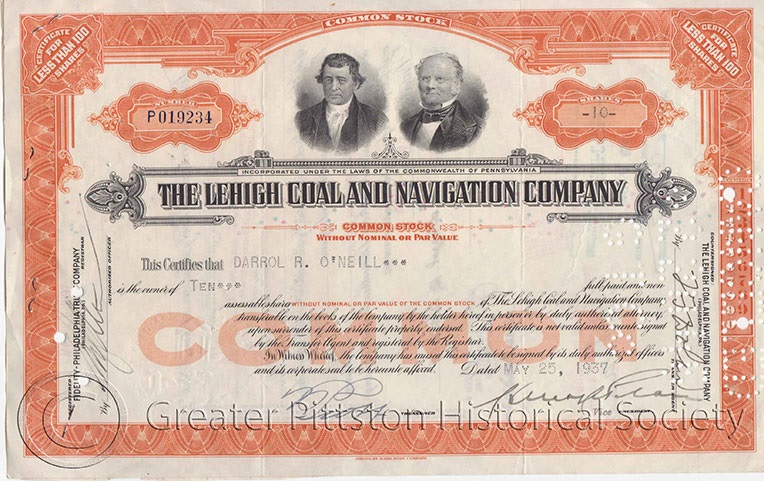
Lehigh Coal and Navigation Company Stock Certificate (1937), Mike Savokinas Collection (0000.1.1014), Greater Pittston Historical Society, Pittston, PA.
This image shows a Lehigh Coal And Navigation Company (LC&N) stock certificate. The certificate is in the amount of ten shares, which was a low and common amount for most entry-level coal investors. The date of the certificate says that it was purchased on May 25th, 1937, by Darrol R. O’Neill. While we do not know much about O’Neill, the LC&N has a rich history in the region. Founded in 1820 by industrialists Josiah White and Erskine Hazard (pictured at the top of the certificate on the left and right, respectively), the company had grown by the 1930s to include thousands of investors. According to an annual report given to its shareholders, in 1937 the LC&N earned over a million dollars (despite the economic depression still wrecking the US), and had a grand total of 1,929,064 shares sold, suggesting that there were thousands of investors that were looking to make a few dollars in the stock market despite its recent crash. The company’s net worth in 1937 was around $40 million, which would be approximately $6.6 billion in 2015.
White and Hazard were early pioneers in the mining and transportation of anthracite coal. In establishing the LC&N, their plan was to combine the industrial coal company and a transportation company to reduce costs of mining and transportation, and increase the profits of the venture as a whole. This was called vertical integration, and was actually a fairly common industrial strategy in the nineteenth century. The company is known for building one of the first coal railways in the country. The LC&N’s headquarters was built in downtown Mauch Chunk in Carbon County, PA (today’s Jim Thorpe) across the street from the LC&N’s Train Station. Even though the headquarters was not in Pittston, the day-to-day mining operations and railroad lines were based around the Greater Pittston area. The company operated several railroads in the Wyoming and Lehigh Valleys, and invested in the Wilkes-Barre – Scranton Railway Co. The company remained a staple in the region until the 1980s, when it was forced to dissolve due to falling coal prices on the global market.
—Cody Spriggs
Running the Family Store
Ms. Ronne Kurlancheek is a third-generation owner of a retail home furnishings store named Kurlancheek’s, which was located on Main Street in Duryea, Pennsylvania.
Ronne recounted that the Kurlancheeks emigrated from Lithuania around 1890, originally settling in the Carbondale, Pennsylvania, area. Ronne’s grandparents, Jacob and Sadie, moved to Duryea, Pennsylvania, and opened a small store on the Main Street in 1898.
The Kurlancheek store originally sold coal mining equipment and tools for the local coal mining businesses, shortly expanding into selling household tools and hardware to the local residents, Ronne recounted.
“The store started on Main Street with mining supplies and expanded to hardware, and then to wallpapers, and then someone suggested that he put some furniture in on consignment, and try it. And that was the beginning of Kurlancheek Home Furnishings.”
At the time of the Kurlancheek family’s emigration, both locally and nationally, women were not typically involved in retail business. They were expected to get married, mind the home, and raise the children. Unmarried women would often gain employment in clerical or domestic functions, or if they were educated, they would often teach elementary school.
During World War II, however, more women entered business and industry, in order to replace the often entry-level vacancies of the men called for military service. Conversely, once the war was over, men returned home and reentered the domestic workforce, thereby allowing women to return to more traditional gender roles. This process stimulated both the Nuclear Family era and resulting Baby Boom generation.
Even rarer was the involvement of women in the daily management and decision-making processes within business. However, Ronne explained that her mother and her grandmother were both very involved in managing the store, right from the start, and well before the period when this became more commonplace. She considered them pioneers in this respect.
“…my mother and father were both in the business. And my grandmother and grandfather were in the business. And that was a time when women weren’t particularly in business. And my mom really worked almost as many hours as my dad, and she was a salesperson, almost the interior designer of her day—even though she did not have formal training, she had a real knack for it.”
Women in business was a Kurlancheek family tradition, including not only her mother and grandmother, but also her two sisters and herself.
“…my two sisters owned the Tudor Book Shops: one in Scranton and one in Kingston…so we all went into retailing.”
Over the years, the Kurlancheek family home furnishings business expanded the storefront in Duryea, and the family opened two more stores, one in Scranton and the other in Wilkes-Barre, Pennsylvania.
Ronne recounted that her aunts and uncles owned and managed these two newer stores, and when her father Ben was old enough, he took over management of the original store in Duryea.
“I’m very proud of my grandparents and parents—that they started with nothing. My grandfather came over here with nothing and started with just a wagon full of odds and ends, and he went from town to town selling that. And he developed a real business that he could pass down to his children, and he provided a business for each of his children…”
Ronne explained that although the three stores eventually closed, in 2005 she reopened a new store named Kurlancheek Home Furnishings located in Wilkes-Barre, Pennsylvania. She has continued the Kurlancheek family tradition of women’s involvement in retail business ownership and management for over one hundred and fifteen years.
The Kurlancheek family embodied the ideal of the “American Dream,” having displayed how hard-working Jewish immigrants from Lithuania could not only survive, but also thrive in America. Moreover, the Kurlancheek women, in particular, were innovators with regards to their level of responsibility and contribution of women in business management, and therefore well ahead of their time.
—Patrick Gallagher
Listen to more of Ronne’s story in this video slideshow, courtesy of Mike Lizonitz and GPHS.
Women in Business

Image courtesy of Dave Janoski (editor), Greater Pittston Progress (a Civitas Media Property). Available online at: http://pittstonprogress.com/news/local-women-honored-at-st-pat-s-day-dinner-1.1847387
In March 2015, the Greater Pittston Chamber of Commerce awarded Helen Brigido the first ever Distinguished Woman Award. Since 1972, Brigido has owned and operated Quality Roofers, Builders, and Hardware, a staple retail store in downtown Pittston. She and her husband opened the business to help facilitate her husband’s construction business. Helen’s business sense was formed over many years working in customer service and as a manager for Allan’s Shoe Store. She entered the workforce in the late 1930s when she was still in high school — a critical time in American history — as her wages were needed to boost the family income. When the US entered World War II in 1941, the manager of a local shoe store was drafted and the job was offered to Helen. She was hesitant in taking the job, but she eventually accepted the position. She explains that she wasn’t prepared for being a manager, because her previous experience had only been as a sales clerk:
“…So then Mr. Amico was the manager of Allan’s and they drafted him so then Mr. Branlan asked if I would like the job as manager. I said, oh Mr. Branlan I don’t have any experience as a manager! I’m only a sales clerk… so I went to work for him … and I was manager for 15 years.”
When the war ended, Helen and her husband, Guy, rented out part of their triplex home and she gained further experience managing her tenants. At a time when women left the workforce, Helen continued to work part-time, tending to her nieces and nephews and her own children in the interim. When her children grew older and her husband began working in construction, they opened their store, Quality Roofers, Builders, and Hardware. This store has supplied the do-it-yourselfers of Pittston for over forty years. Helen found success in offering an alternative experience to larger retail hardware stores: she sold individual customers small quantities of nails, nuts, and bolts, allowing customers to pay just pennies for a single nail instead of selling only larger bulk packages. She proudly recounted stories of people coming in and being happy for being able to buy nails individually rather than in packages.
Helen’s hard work through the ages has provided her with great memories and many good friends, and she’s left a lasting impression on the City of Pittston. Her connection to the community, through her experiences as shop manager, landlord, and hardware-store owner, made her a pioneer in local business and a remarkable role model for young women.
—A.J. Mancini
Post-Industrial Retail Businesses in Downtown Pittston

Main Street Pittston, c.1950. Mike Savokinas Collection (MS0349c), Greater Pittston Historical Society, Pittston, PA.
Mr. Blair Corcoran was a third generation owner of a retail men’s clothing store named Corcoran & O’Brien, which was located on Main Street in Pittston, Pennsylvania. The store is seen on the far right of this photograph of downtown Pittston, after a heavy snowfall during the 1950’s.
Blair’s great-uncle, John B. Corcoran, established the store with Charles H. O’Brien in 1887. At the time, Pittston was a city located within the heart of the booming and lucrative anthracite coal-mining industry in Northeastern Pennsylvania.
The Corcoran family acquired full ownership of the store, after buying-out the O’Briens’ interest, but they kept the store’s original name. Store ownership eventually passed to Blair’s father Harry Corcoran, and then to Blair, himself.
Blair recalled that downtown Pittston during the mid-twentieth century was a thriving and bustling city, with shops for all consumer needs, and was a safe place to live and work.
“The town was a booming town. At one time there were over twenty-five, twenty-six men’s clothing stores…there was a store for everything. You didn’t have to go to Wilkes-Barre. You didn’t have to go to Scranton to buy anything, everything was right here in town…you had to dodge people walking up and down the sidewalks. The sidewalks were crowded with people just going to and from, either work or to the bank or to the different businesses on the main street there, but it was quite a town; it was quite a town.”
The family retail store Corcoran & O’Brien provided quality men’s clothing, particularly suits, for affordable prices, according to Blair.
“…we had a suit club. They [men] would pay a dollar per week for twenty-five weeks. They would come down and put a dollar a week on the suit club, and they would take a chance of maybe winning that suit club and get what they paid into it plus the remainder of the twenty-five weeks… boys’ suits [sold] for five dollars or seven fifty.”
By the 1970s and 1980s, as with many towns and small cities in the US during that period, and due to a variety of local and national economic factors, shops began to leave downtown Pittston. This included the departure of two major department stores, Blair explained.
“My father believed that you needed major department stores to anchor a town, and we were losing quite a few stores at that particular point…”
Economic factors as well as Pittston City Council decisions had detrimental effects upon the downtown businesses, including his own, according to Blair. These Council decisions included endeavors to attract shopping malls in the Pittston area, and an effort to create more automobile parking in the downtown area. As Blair notes,
“…they have the parking space now, but they have no retail stores now…they chased away a lot of the retail stores outta here and now they have no tax base…”
These issues led to the closure of most retail store businesses in downtown Pittston, including Corcoran & O’Brien in 1992. By the time of its closure, Corcoran & O’Brien was the last men’s retail clothing store to leave and had been in business for over a hundred years.
In an effort to facilitate a recovery of the downtown, the City of Pittston continues to look for innovative ways to attract new businesses in order to replace the ones which had been lost, such as Corcoran & O’Brien.
–-Patrick Gallagher
Sources:
Helen Brigido Oral History, Nov 2014, interviewed by Mary Policare. Collections of the Greater Pittston Historical Society, Pittston, PA.
Blair Corcoran Oral History, 21 Feb 2015, interviewed by Mary Policare. Collections of the Greater Pittston Historical Society, Pittston, PA.
Ronne Kurlancheek Oral History, 29 May 2015, interviewed by Mary Policare. Collections of the Greater Pittston Historical Society, Pittston, PA.
Ketchum, Milo Smith. The Design of Mine Structures. New York: McGraw-Hill, 1912.
Lehigh Coal & Navigation Company, “117th Annual Report to Stockholders” (Philadelphia: Lehigh Coal & Navigation Company, 1938), University of Pennsylvania Lippincott Library Special Collections. Available online at: http://www.library.upenn.edu/collections/lippincott/corprpts/lehigh/lehigh1937.pdf
http://pittstonprogress.com/news/local-women-honored-at-st-pat-s-day-dinner-1.1847387
Mining the Past Entertainment & Leisure Patriotism & Politics Religious & Family Life

